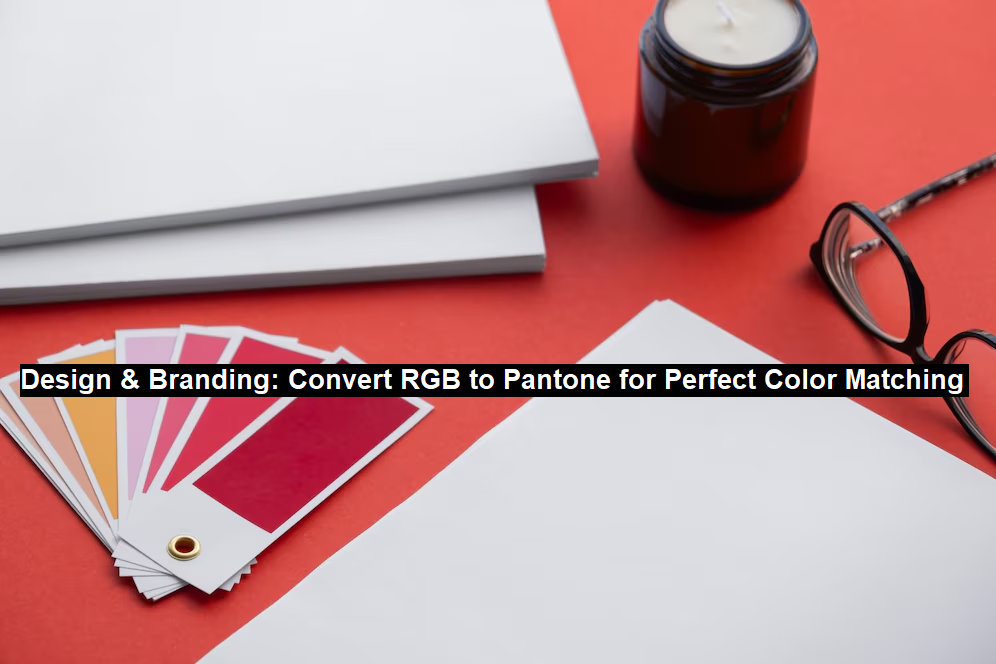Color plays a pivotal part in branding and plan. Whether it’s a symbol, promoting fabric, or item bundling, steady color representation over diverse media is basic. In any case, accomplishing color consistency can be challenging due to the contrasts between computerized and print color spaces. RGB (Ruddy, Green, Blue) is the standard color demonstrated for advanced screens, whereas Pantone gives a standardized color coordinating framework fundamentally utilized in printing. Changing over RGB to Pantone guarantees precise color generation, upgrading brand personality and consistency.
This directly investigates the significance of changing over RGB to Pantone, the strategies to do so, and best homes for guaranteeing color exactness.
Understanding RGB and Pantone Color Systems
RGB Color Model
RGB is an added substance color demonstrated utilized for advanced shows, counting computer screens, smartphones, and tvs. It makes colors by combining ruddy, green, and blue light in shifting force.
- Additive Mixing: When all three colors are at full intensity (255,255,255), they produce white; when at zero intensity (0,0,0), they produce black.
- Device-Dependent: RGB colors can vary depending on screen calibration, brightness, and ambient lighting conditions.
Pantone Color System
Pantone Matching System (PMS) could be a standardized color framework utilized in printing and fabricating. It comprises premixed ink colors, guaranteeing consistency over diverse materials and print forms.
- Consistent & Universal: Unlike RGB, Pantone colors remain consistent regardless of the printing method or substrate.
- Spot Colors vs. Process Colors: Spot colors are pre-mixed and applied separately, while process colors (CMYK) are mixed using cyan, magenta, yellow, and black.
Read: Unlock Business Potential with HubSpot Development Services in the USA
Why Convert RGB to Pantone?
1. Brand Consistency
For brands, maintaining color integrity across various media is critical. A brand’s logo should look identical on a website (RGB) and printed brochures (Pantone).
2. Avoid Color Variations
RGB colors may show up distinctive on distinctive screens, making it troublesome to guarantee color precision when printing. Changing over to Pantone anticipates startling shifts in color.
3. Professional Printing Requirements
Printers utilize CMYK or Pantone rather than RGB. Changing over to Pantone guarantees the closest conceivable coordinate to the advanced plan.
4. Better Material Adaptability
Distinctive materials, such as paper, texture, and plastics, respond in an unexpected way to inks. Pantone gives particular codes for distinctive substrates, guaranteeing precise color generation.
Methods to Convert RGB to Pantone
1. Using Adobe Illustrator or Photoshop
Adobe Creative Suite provides built-in tools for converting RGB to Pantone.
Steps in Adobe Illustrator:
- Open the file and select the colored object.
- Go to Window > Swatches and then Window > Color.
- Click on the Color Guide panel and select the closest Pantone match.
- Convert the selected RGB color into Pantone using the Recolor Artwork tool.
Steps in Adobe Photoshop:
- Open the image and select the color using the Eyedropper tool.
- Go to Color Picker > Color Libraries.
- Choose Pantone Solid Coated or another relevant Pantone book.
- Photoshop suggests the closest Pantone match.
2. Using Pantone Connect
Pantone Connect is a digital tool available as a plugin for Adobe and a standalone application.
Steps to Use Pantone Connect:
- Upload or pick the color in the tool.
- The system provides the closest Pantone match.
- Save or export the Pantone value for reference.
3. Online RGB to Pantone Converters
Several online tools can convert RGB values to Pantone:
- Pantone Color Finder (official tool from Pantone)
- EasyRGB
- RGB2Pantone converter
Steps for Online Conversion:
- Enter the RGB values.
- The tool provides the nearest Pantone color.
- Compare and adjust if necessary.
Challenges in RGB to Pantone Conversion
1. RGB and Pantone Color Differences
RGB produces a broader range of colors than Pantone, which means some colors may not have an exact Pantone equivalent.
2. Lighting and Material Effects
Colors appear different under various lighting conditions and on different materials. Testing a Pantone color on the actual material before production is recommended.
3. Monitor Calibration Issues
If your monitor isn’t calibrated correctly, RGB colors may not represent the actual Pantone outcome.
Best Practices for Accurate Color Matching
1. Use Pantone Swatch Books
For physical reference, Pantone swatch books provide a precise representation of colors on different materials.
2. Work with a Professional Printer
Printing professionals can help select the best Pantone colors for a project.
3. Convert Early in the Design Process
Choosing Pantone colors early ensures a smoother transition from digital to print.
4. Consider CMYK Conversions
If a Pantone match isn’t available, converting RGB to CMYK and then choosing a Pantone color may be an alternative.
Conclusion
Changing over RGB to Pantone is basic for keeping up color precision and brand consistency over advanced and print mediums. Whether utilizing plan computer programs, online converters, or Pantone instruments, understanding the contrasts and challenges in color transformation makes a difference when the leading comes about. By taking after the best phones and working with experts, creators can guarantee their brand colors stay steady and impactful over all stages.


